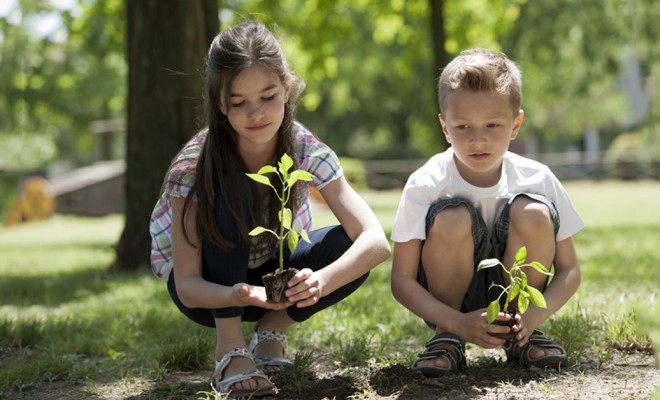
Child Development
Outdoor Play
Frequently repeated parental anecdotes concerning younger children playing just as much with the box and wrapping materials as the toy itself, though often embroidered for social effect, nevertheless reminds us that a huge amount of child’s play is naturally characterised by divergent broadening of horizons and exploration of possibilities. Despite the burgeoning toy industry, the need for children to experience the joy and sensation of playing with natural materials has been well understood since the early 20th century.
Fostered by Steiner Waldorf schools in particular, this hands-on approach to early years education advocated the importance of free play and interaction with nature and natural elements. Continuously developing and promoting this educational philosophy, the Steiner Waldorf movement has championed the principle of parents, teachers and children getting their hands dirty as a fundamental part of grounding children in the natural world in order to reap the multi-faceted benefits such exposure inevitably bestows.
Providing outdoor play opportunities
Within nursery environments, the task of providing such (often outdoor) natural experiences has become more challenging due to the attendant safety and resource issues which accompany organised trips and excursions to parks, community farms and similar. This has prompted some nurseries to compensate for this by bringing considerably more natural materials into the nursery environment where such problems are easier to staff and manage.
[Helpful article: Learning through Rough & Tumble Play, the Benefits & Legislation]
As a result, many younger children now get to play heuristically with a range of dirty, messy natural materials far more frequently: the properties and possibilities of sand, mud, clay, water and sticks are thus endlessly and exhaustively explored amidst an atmosphere of rapt engagement which is the sole prerogative of the young, and the young-at-heart. This in turn gives many opportunities for extension activities appropriate to the age and experience of the children. For instance, mud shapes can over time lead on to moulded brick shapes, and these can then be used to prompt possibilities for using the brick shapes to build larger structures. Later, when modern building blocks are introduced into play, the links already established underpin and facilitate the child’s understanding of the concept and possibilities of building blocks. This link between the primary function and purpose of natural materials and the exploration and application of secondary possibilities is an effective means of allowing discovery learning to flow on into developmental tasks which expand and deepen a child’s understanding of the place and usage of these materials in our physical world.
An important ancillary benefit is that getting children to play with natural materials in this way helps to combat the worst effects of our ‘hygiene culture’ which has been linked with the rise of allergies and conditions once absent from our society or present at extremely low-risk levels, as in the ‘less-developed’ countries of the modern world. Though it is now well known that a lack of exposure to parasites, bacteria, and viruses in childhood tends to result in auto-immune system problems for adults, theories as to why this should be the case continue to evolve.

Detriment to natural immunisation
In 1989, Dr David Strachan’s observation that allergies like eczema and hay fever were much less prevalent in children from large families prompted him to hypothesise that greater germ-exposure was the reason for this improved resistance, and follow-up research found this greater immunity was also shared by children from farming backgrounds.
Fourteen years later in 2003, immunology research by Professor Graham Rook, BA, MB, BChir, MD. Centre for Clinical Microbiology UCL (University College London) proposed his ‘old friends’ hypothesis. Here, Rook maintained that, far from being an immunity acquired in childhood, the human gut contains microbes developed by ‘homo sapiens’ at the dawn of the species. These, Rook argued, establish low-level infections we carry and tolerate which help our immuno-regulatory systems ‘learn’ to protect us. Thus, in response to our modern ‘ultra-hygienic’ lifestyles, our immune systems – now starved of these microbes – are apt to go haywire because, as Rook graphically explains: ‘it’s not just the trivial matters of everyday domestic hygiene. It’s the fact that we no longer drink water from the stream and we no longer have worms.’
Immunologists have refined Rook’s theory and now believe the human gut requires a ‘microbial diversity’ of bacteria to build a robust immune system. Our body’s ‘T cells’ are programmed to respond to infectious agents by upgrading our immune system defences accordingly, and cradle-to-grave cleanliness seems to significantly impede this natural process, instead delivering a nasty 21st-century cocktail of autism, ADHD, food allergies, leaky gut, and childhood obesity.
[Helpful article: Interactive Technologies Impact on Child Development]
Out educate the competition
The ongoing research into heuristic play with natural materials has implications for nurseries. As outlined above, it has now been clearly established that providing access to a varied play environment where these experiences are a regular feature has a range of positive impacts upon child development. This has been clearly spelt out by Bradley and Elardo:
‘The availability of toys in infancy is related to the child’s IQ at three years of age. Children with access to a variety of toys were found to reach higher levels of intellectual achievement, regardless of the children’s sex, race, or social class (Bradley 1985, Elardo 1975).’
Thus nurseries must have clear enrichment strategies in place or risk losing out to competing child-care services offering more comprehensive and holistic facilities.
Nursery managers may like to reflect how their in-house learning and development programmes incorporate varied learning materials and equipment, and consider their response if, for example, a parent, or Ofsted inspector, asked: ‘What particular advancements in children’s development does this type of programme promote?’
[References]






Pingback: Interactive Technology & Child Development |
Pingback: Rough & Tumble Play Improves Child Development
Pingback: Cognitive Development by @wescogb | UKEdChat - Supporting the Education Community